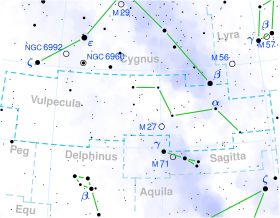| Observation data Epoch J2000 Equinox J2000 | |
|---|---|
| Constellation | Vulpecula |
| Right ascension | 20h 15m 15.89542s [1] |
| Declination | +25° 35′ 31.0549″ [1] |
| Apparent magnitude (V) | 4.60 - 4.80 [2] |
| Characteristics | |
| Spectral type | B3Ve + A7V [3] |
| U−B color index | −0.73 [4] |
| Variable type | γ Cas [2] |
| Astrometry | |
| Radial velocity (Rv) | −7.00 [5] km/s |
| Proper motion (μ) | RA: +6.93 [1] mas/yr Dec.: −3.89 [1] mas/yr |
| Parallax (π) | 3.29±0.51 mas [1] |
| Distance | approx. 1,000 ly (approx. 300 pc) |
| Absolute magnitude (MV) | −2.56 [6] |
| Details | |
| A | |
| Mass | 4.7 [3] M☉ |
| Luminosity | 3331 [6] L☉ |
| Surface gravity (log g) | 3.49 [7] cgs |
| Temperature | 18,700 [8] K |
| Metallicity [Fe/H] | −0.10 [7] dex |
| Rotational velocity (v sin i) | 160 [9] km/s |
| Age | 100 [3] Myr |
| B | |
| Mass | 1.8 [3] M☉ |
| Age | 100 [3] Myr |
| Other designations | |
| QR Vul, BD+25°4165, CCDM J20153+2536AB, GC 28140, HIP 99824, HR 7739, HD 192685, SAO 88410, WDS J20153+2536AB | |
| Database references | |
| SIMBAD | data |
HD 192685, also known as QR Vulpeculae or HR 7739, is a binary star [3] about 1,000 ly away in the Vulpecula constellation. It is visible to the naked eye.

